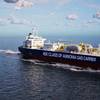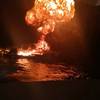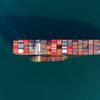News Briefs
First Wave/Newpark Shipbuilding, in Galveston, Texas, has had a busy spring. First, the company was awarded a contract by Diamond Offshore Drilling to install a crane and perform annual survey work on Ocean Lexington. That contract was completed in March.
Next, the company won a contract from Smit Americas, Inc. for drydocking of Ocean Hercules. The vessel was drydocked on the shipyard's 7,500-ton drydock for general maintenance and conversion from a seismic vessel to a telecommunication cable laying vessel.
Finally, First Wave drydocked Pride Louisiana for Pride Offshore. The rig was docked in the Galveston Ship Channel, utilizing a heavy lift barge for an annual survey. The rig will depart upon completion of the survey.
Conrad Industries Announces Stock Repurchase Program
The board of directors of Conrad Industries, Inc., has authorized the company to repurchase up to 200,000 shares, or $1 million, of its outstanding common stock. Based on the current fair market value of the common stock, this will allow the company to repurchase approximately three percent of the approximately 7.1 million shares of the company's common stock outstanding.
Management may repurchase shares from time to time in the open market at prevailing prices, or through privately negotiated transactions depending on prevailing market conditions. The shares will be held as treasury and will be available for use in connection with the company's stock option plan, and other compensation programs, or for other corporate purposes.
A&B Industries Renovating Transport Vessel
M/V Capt. Johnny 1, a 176 ft. Caribbean transport vessel is being renovated at A&B Industries Shipyards, Morgan City, La. Owned and operated by Trailer Transport Express, Ltd., St. Thomas, U.S. Virgin Islands, the vessel is a converted OSV, which had operated in the Gulf of Mexico supporting the offshore oil industry.
The vessel now runs between the U.S. mainland and island-to-island, delivering trailers and containers of cargo in the Caribbean with its stern ramp. Trailers and containers can be driven on and off the vessel without dockside assistance. During drydocking, extensive work was completed on the stern of the vessel. The bottom plate from the engine room aft bulkhead to the stern wraparound was replaced, along with other sections of bottom plate. Nearly all the bulkheads, deck and stiffeners aft of the engine room bulkhead to the stern wraparound were also replaced. The wheels, rudders and shafts were removed and reworked to original specifications. The bottom was blasted, painted and anodes installed before coming off drydock.
The stern ramp was removed before drydocking for modifications, and to be blasted and painted before being reinstalled. As part of the renovation, the main engines, generators and gears were completely rebuilt and installed and aligned. The vessel is expected to return to service in the Caribbean this spring.
An American Classic on Columbia
"We took the existing Cummins KTA38 M2 940 hp engines and moved them outboard to an auxiliary machine compartment. We derated them to 650 hp and linked them to Schottel SRP 330 Z-drives. Then we installed new KTA38 M2 engines rated for 1,350 hp at 1,950 rpm on the existing foundations with new six-in. shafts and 54-in. props."
That is Rodney Lay and Associates' naval architect Matt Pitman's short version of the extensive modifications carried out on the hull that American Classic Voyages Co. is finishing out as a cruise vessel. It had originally been designed as a casino boat.
To service Columbia Queen's interior spaces, with accommodations for 57 crew in addition to 81 passenger cabins for up to 161 guests, the boat is equipped with a full complement of gen sets. These include two Cummins KTA38-powered 750kW gen sets along with a Cummins KTA19-powered 275kW emergency gen set. The boat's eighth engine is a six-cylinder Cummins 855 powering the bow thruster.
With construction partially started at LeeVac shipyards in Jennings, La., the 218 x 64-ft. vessel was purchased by American Classic Voyages. The company brought unfinished Columbia Queen to the Northwest where the engine room renovations and passenger space completion are being carried out at Cascade General's Portland shipyard. Columbia Queen will operate as the fourth vessel in AMCV's subsidiary company, The Delta Queen Steamboat Co., the oldest U.S.-flag cruise line, with roots dating back to 1890.
The Delta Queen Steamboat Co. currently offers 3-to 14-night cruises on the Mississippi River system aboard three steam powered paddlewheelers: National Historic Landmark Delta Queen as well as Mississippi Queen and American Queen, the world's largest steamboat. The addition of Columbia Queen represents the company's first venture into the Pacific Northwest.
Piloting Columbia Queen on the seven-night, 1,000 mile vacations originating in Portland, Ore. and travelling the Columbia-Snake river system from Astoria as far east as Lewiston, Idaho, will be Capt. Lou Boone.
He says, "We hope to be able to make 11 knots to handle currents the Columbia River is so well known for. Additionally, because the engines are in two separate engine rooms -- as is the emergency generator -- we have increased the safety level of the vessel."
Sea trials for Columbia Queen are scheduled for mid-May with the vessel commencing passenger service on May 27 in time for the 2000 summer and fall vacation seasons.
Internet-based Update Service for Digital Nautical Charts
A radically new update service for raster nautical charts is now available via Internet email, the Commerce Department's National Oceanic and Atmospheric Administration (NOAA) announced. This first-ever electronically-delivered weekly update service is a joint effort between NOAA's National Ocean Service and Maptech Inc, the official source for NOAA electronic charts.
Maptech's latest edition raster charts -- or charts for use on a computer -- are a commercial product produced under a cooperative research and development agreement (CRADA) with NOAA. These charts now have an optional package which will provide weekly updates to be applied via a small "patch file" delivered by email. Consumers who purchase the update can have the patches automatically applied to screen versions of the charts, or they may be used to create new chart editions on their computer's hard drive.
"With raster charts now outselling paper charts by almost two to one, and the proliferation of the Internet, it makes perfect sense to have an Internet-based weekly update service for the maritime industry," said Capt. Dave MacFarland, director of NOAA's Office of Coast Survey.
Weekly updates include notices from the USCG, NOAA's Critical Correction Database, the National Imagery and Mapping Agency, and the Canadian Hydrographic Service. The resulting navigation charts will be the most up-to-date available, and will save mariners time and money previously spent doing their own hand corrections to their charts, as well as improving their ability to navigate safely.
Military Sealift Command Assists EPA
The U.S. Navy's Military Sealift Command awarded a fixed-price contract in the amount of $1.055 million to Cetacean Marine, Inc. ? a Seaward Services Company located in Fort Lauderdale, Fla., for the operation and maintenance of EPA's Great Lakes National Program Office research vessel Lake Guardian and workboat Mudpuppy. This is MSC's first contract for the EPA.
Lake Guardian is a 180-ft. monitoring vessel, and Mudpuppy is a 33-ft. SeaArk marine survey workboat. Both vessels will operate on the Great Lakes out of Milwaukee, and will be used to collect sediment and water samples in the Great Lake basin and connecting waterways in support of water quality monitoring agreements between the U.S. and Canada.
The initial period of the contract ends in March 2001, and four one-year periods could extend the contract into March 2005. If all one-year options are exercised, the contract dollar value could reach $5.84 million.
Sea Patch Deployment Network for Inland Waterways Underway
21st Century Technologies Inc. announced Eagle Control Systems of Baton Rouge, La., has been selected as one of its Inland Waterways Sales Representatives for the Sea Patch, as manufactured by its Trident subsidiary.
Eagle Control Systems has been in the inland shipping industry since 1983 and its president, William A. Rogers, has been in the shipping industry for 27 years. As a manufacturer of a number of marine safety devices, including electronic safety devices such as "tank levels" and "overfill alarms," Eagle Control Systems was a repeat attendee at demonstrations of the Sea Patch.
Eagle Control Systems has joined the Trident team to market the Sea Patch to inland waterway shipping. Discussions are currently underway with a number of inland waterway shippers such as Kirby Inland Marine to promote sales of the Sea Patch. Kirby Inland Marine has more than 2,500 barges in service.
Leaks, punctures and tears in the hulls of barges and ships require the rapid deployment of the Sea Patch. With a rapid response team and deployment network, Trident will establish a floating inventory of Sea Patch's shared "barge to barge" and "ship to ship."
Ribbon-Cutting for New Facilities
U.S. Senator Larry Craig (Idaho) joined Rear Admiral John Davis USN in ceremonial remarks marking both the opening of the new Model Engineering Support Facility and groundbreaking for the Underwater Equipment Laboratory. Rear Admiral Davis is the program executive officer for submarines in the Naval Sea Systems Command (NAVSEA).
The Navy's Acoustic Research Detachment (ARD) uses such state-of-the-art facilities to test technological innovations enhancing submarine signature and hydrodynamic characteristics. ARD belongs to the Carderock Division, a field engineering activity of NAVSEA, the primary user of ARD expertise.
The Model Engineering Support Facility allows simultaneous outfitting and operation of up to five large-scale models, some as long as 98 ft. Testing large models instead of full-size submarines saves on R&D costs. Reid Middleton, a Seattle architectural and engineering firm, handled the design with construction by Triton Marine Construction, Houston, under a $9.1 million contract.
WPC, Inc. of Gig Harbor, Wash. won the $10 million contract to design and build the Underwater Equipment Laboratory (UEL) under the direction of the Naval Facilities Command Engineering Field Activity-Northwest. A 27,000 sq.ft. Acoustic Test and Analysis Center is the centerpiece of the UEL. The UEL completes the ARD master plan, modernizing aging offices, shops, computer labs and government housing, some dating from World War II, into a single 21st Century facility. The result will be greatly enhanced efficiency, as well as a significant improvement in the visual appearance of the site.














